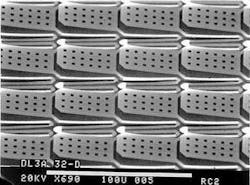Night vision to benefit from microscopic mechanical "eyes"
By Winn Hardin
ORLANDO, Fla. — Today, military night vision goggles use expensive, rare earth materials such as mercury cadmium telluride (MerCad) in their infrared (IR) sensors. These high-resolutions sensors are not compatible with standard silicon fabrication processes, which add to the cost of the systems and limit the acceptance of the technology to rich countries and well-financed armies.
A new sensor from Sarcon Microsystems Inc. in Knoxville, Tenn., and Sarnoff Corp. in Princeton, N.J., could expand the lure of relatively cheap, uncooled IR sensors by cutting the cost in half while improving performance, making the technology more readily accessible.
At the recent SPIE Aerosense and Defense symposium in Orlando, Fla., Sarcon Microsystems Inc. demonstrated how the same principle that makes a home thermostat work can be used to make inexpensive, uncooled IR sensors.
The 320-by-240-pixel focal plane array (FPA) is made of thousands of small micro electro-mechanical (MEMS) sensors that form a rectangular array. Each sensor detects the intensity of IR radiation on the cantilever by measuring its movement in response to IR radiation. The bimetal cantilevers move along the vertical axis when illuminated by long wave IR radiation between 8 and 14 microns.
As the distance between the cantilever and underlying substrate change, so does the capacitance between the two surfaces. A readout integrated circuit (ROIC) converts the amplified signal into an electrical signal that can be displayed in an image format similar to other visible and IR cameras.
null
Unlike MerCad sensors, the cantilever design is compatible with standard silicon micro machining and fabrication processes. The sensor also breaks new ground in MEMS-based IR sensor arena.
A pair of competing technologies, including ferroelectric barium strontium titanate (BST) and amorphous silicon-based microbolometers, uses electrically sensitive MEMS structures rather than mechanical structures such as the cantilever. The mechanical nature of the MEMS devices eliminates Johnson noise, which comes from the thermal agitation of charge carrier.
The mechanical sensor should also lead to improved performance. Uncooled IR imagers are sensitive to temperature changes in the 50 to 100 mK range under standard operating conditions, such as a F1 lens, room temperature operation and 30 Hz frame rates among others, says Doug Malchow, Sarnoff's Imaging & Emulation Business Unit sales manager.
The cantilever sensor delivers sensitivity of 20 to 50 percent per degree Celsius compared to microbolometer designs, which have intrinsic sensitivities of 2 to 3 percent per degree Celsius.
This intrinsic sensitivity means that the cantilever systems have the potential to reach the theoretical background limit of 5 mK, says David Smith, Sarcon's vice president of sales and marketing. Smith adds that, under the above stated standard conditions, the microcantilever sensor performs on par with high performance cooled systems such as mercury cadmium telluride.
However, Malchow strongly cautions that the sensor has yet to be tested for minimum sensitivity and that under non-standard conditions, such as imaging in very cold environments such as space, systems using Stirling-type or cryogenic coolers would outperform the uncooled microcantilever sensor.
The first IR detector engines will be available by early 2004, with commercial production due by late 2004, Smith says. Sarcon officials declined to set an initial purchase price, but experts put estimate the cost of the devices in volume to be around half that of microbolometer-based sensors, which can retail in volume for as little as $4,000.

